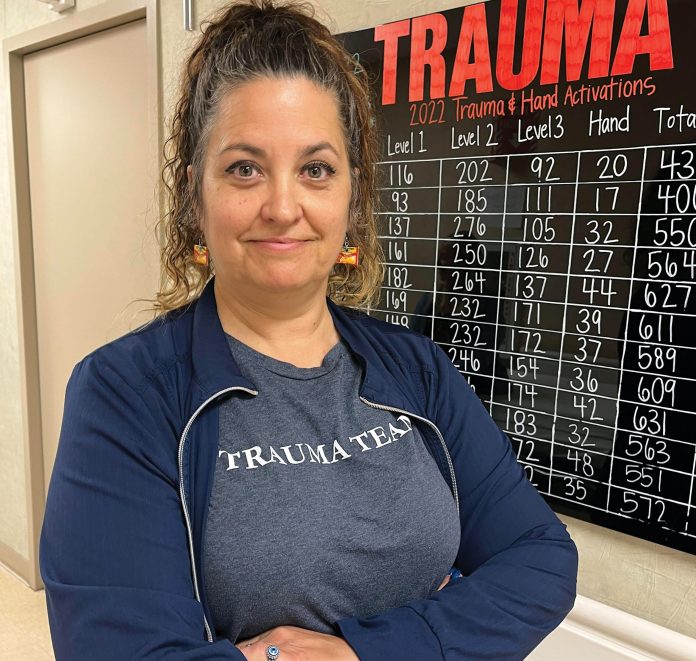story and photo by James Coburn, Staff Writer
The University of Oklahoma Medical Center is in the process of developing a dedicated certified burn center for trauma patients, said Denni Wilson-Lowber, RN, trauma burn coordinator.
The number of patients with severe burns has increased drastically at the hospital from 3200 activations four years ago. Activations in 2022 were 6700.
Lowber was asked to take over the burn control position two years ago to coordinate the burn program because she had built an extracorporeal membrane oxygenation (ECMO) program in California. ECMO involves taking blood from a vein in the groin to run through a machine for oxygenation without the function of the lungs.
“We found out it was quite helpful for patients with COVID,” Lowber said. “That was just an extra thing we had to figure out because the lungs were so congested.”
Lowber earned her Bachelor of Science in Nursing degree 25 years ago at the University of Texas in Arlington. Most of her career involved trauma in the operating room and high acuity cases with open heart surgery and transplants.
The University of Oklahoma Medical is unique for having the only level-1 trauma emergency center in the state. Patients with multiple trauma injuries are taken there.
“We decided it would be in the patients’ of Oklahoma’s best interest to build a burn center to be able to treat these injuries according to the American Association Burn Guidelines,” Lowber said. (story con tinues below)
The hospital is in the process of moving forward after COVID issues that hit all Oklahoma hospitals delayed the burn center’s development. A completion date is yet to be set for the project. However, OU Health, now being a not-for-profit status, is prepared for the journey.
“What has been submitted for review is a comprehensive unit to have a couple of operating rooms. One of them will be dedicated just for the wet treatment,” Lowber said. “That will be for patients who don’t necessarily need full anesthesia. They can have conscious sedation and we can take care of all of their injuries at the same time in an environment that is safer.”
The second operating room will be dedicated for skin grafting and scar revision. It will be a comprehensive unit for patients to be able to stay in the same bed as they step down in levels of care, Lowber said. A collaborative model of nurses will offer the most appropriate patient care according to their duty.
“Today they might need this ICU nurse, but three days from now they would be able to step-down to like a med/surg nurse,” she continued. “So, we will be able to be flexible with that to take care of them.”
The interdisciplinary team will render whatever care is necessary for each patient. This will involve psychology, social work, case management, physiatry, and palliative care forming a cohesive range of caregivers in one dedicated unit.
For this project, OU Health will be hiring many more nurses. Burn nursing is a totally different modality, Lowber explained. Burn nurses build a rapport with families to follow patients for the rest of their lives. The average large burn patient is hospitalized for two to three months. The nurse becomes an intrinsic part of that family.
“I still keep up with my burn patients from years ago to this day because you become so encouraged by their strength,” Lowber said.
One of her patients from about 18 months ago recently sent her pictures of her graduation from Navy boot camp.
Burns associated with Independence Day often get the most attention but are less common. Most of them are eye injuries. Sparklers cause a lot of injuries among children by burning at 3,000 to 5,000 degrees, Lowber cautioned. This is a big time of year for fire pits. They remain hot 12-16 hour after being put out with water. Kids wake up and go running around and step on the coals.
Seventy percent of burns are preventable and happen in the kitchen. Ramen noodle soup cooked in microwave ovens result in most pediatric burns. Lowber said a microwave oven gets 100-degrees hotter than the boiling point of water. Kids pull the noodles out of the microwave that is higher than they are. So, the hot noodles and liquid comes down on their face and chest, usually both legs and an arm to the crotch. The seasoning packet turns it into a more problematic grease burn.
Every day, burn patients think if they have the strength to continue their treatment.
“It’s amazing to see every single day, having intense discussions with them about, ‘You don’t need to worry about tomorrow. Worry about right now. And you can do, right now.’ And every single day they discover they made it. And then they’ve made it for a week.”
To learn more about the University of Oklahoma Medical Center, visit https://www.ouhealth.com/careers/.












